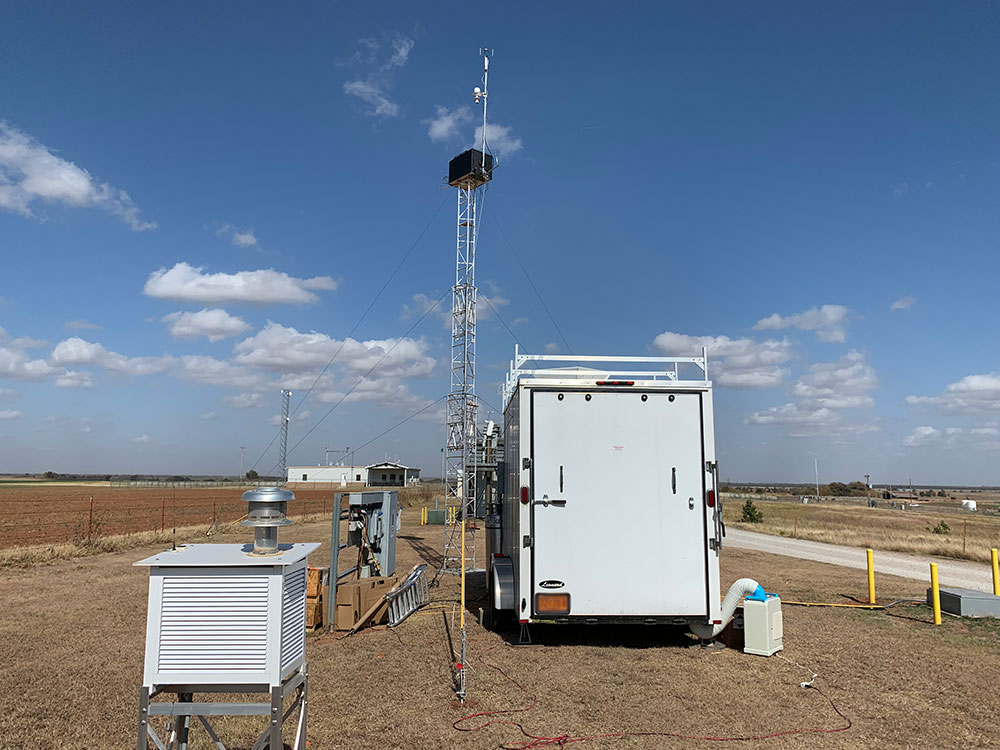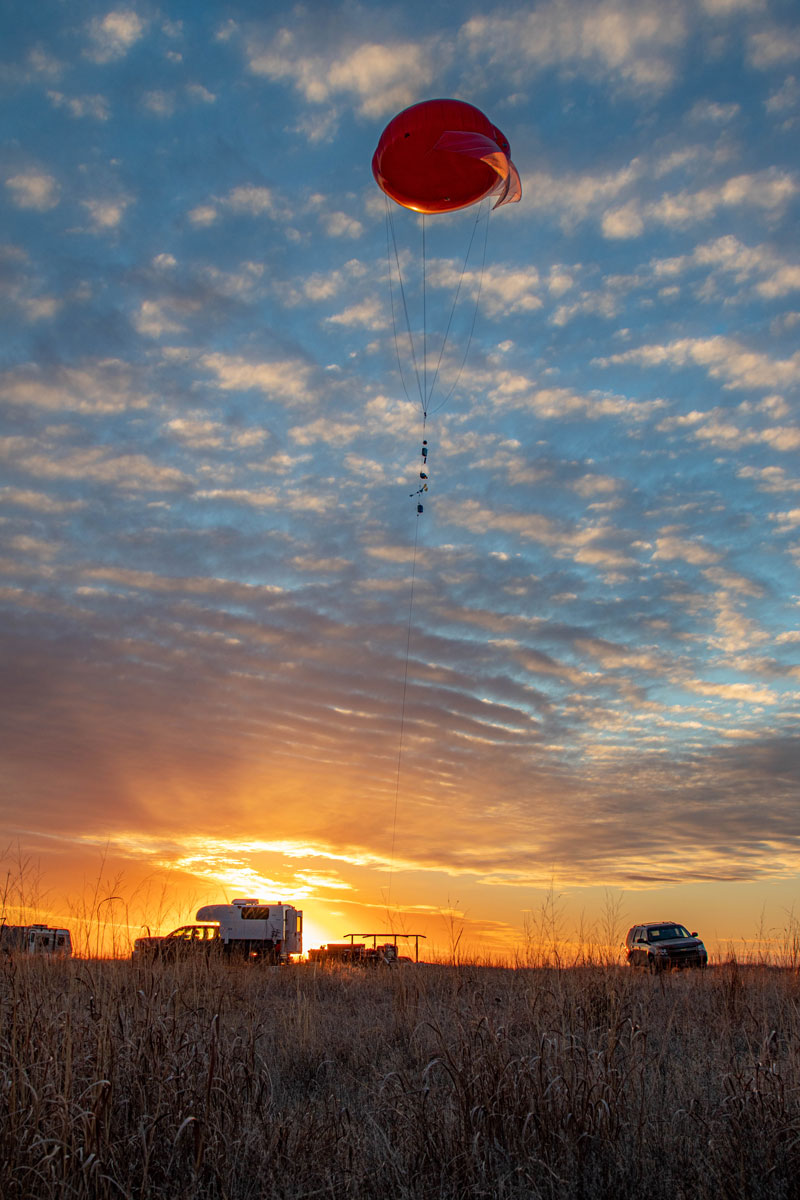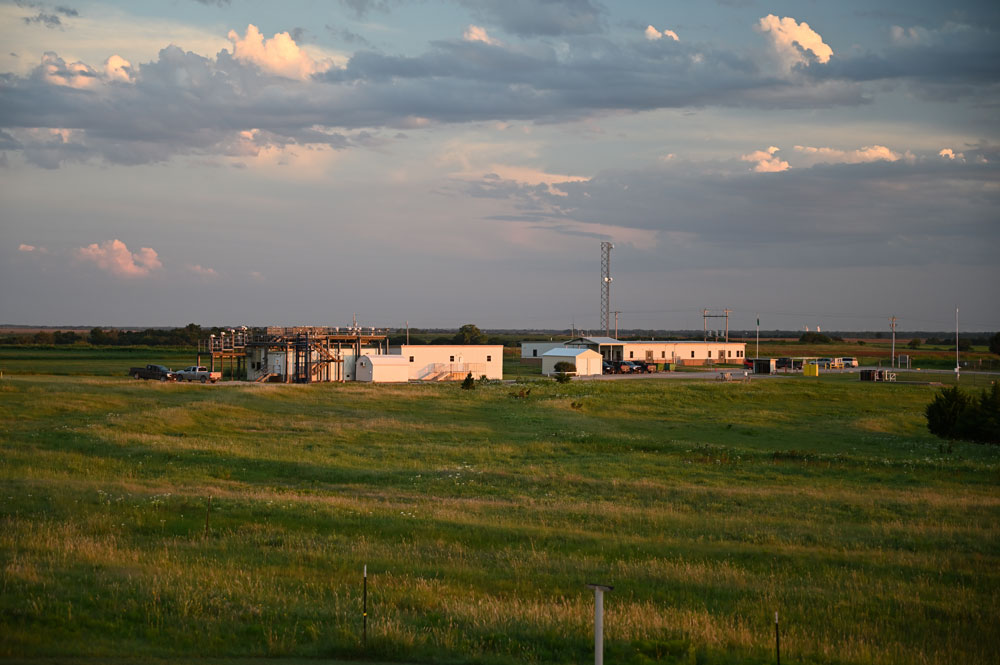Pandemic Slows but Does Not Stop ARM’s Southern Great Plains Operations
Published: 19 April 2021
Most instruments kept running during brief observatory closure in 2020; activities are building back up in 2021
Editor’s note: This is the second article in the “Science Still Going, ARM Data Still Flowing” series looking at how ARM has continued to support atmospheric science during the pandemic.
When people began to stick close to home early in the COVID-19 pandemic, the effects trickled down to the Atmospheric Radiation Measurement (ARM) user facility.
With many researchers unable to travel because of institutional restrictions, ARM sites faced some significant reshuffling of their 2020 field campaign calendars. At ARM’s Southern Great Plains (SGP) atmospheric observatory, 15 of 17 planned campaigns were delayed.
In addition, because of growing COVID-19 impacts in Oklahoma, the SGP was closed from April 4 through May 3. During that period, staff stayed offsite, and instruments that could not run on their own were shut down.
The closure did not halt everything at the SGP. Most instruments kept operating under remote supervision, and some campaigns continued, such as the Pilot Aerosol Microphysics Network for Targeting Climate Model Uncertainty. This campaign, known as POPSnet-SGP, is collecting data on aerosol number concentrations and size distributions using three-dimensional printed optical particle spectrometers (POPS) set up around the SGP. The POPS and other aerosol instruments deployed for the campaign are designed to operate unattended.
The SGP started a phased reopening May 4 and has been in Phase 2 of its reopening plan since May 25, meaning that visit requests are being considered on a case-by-case basis. Some campaigns have not required researchers to be onsite; two of those campaigns went on in 2020 as scheduled after the phased reopening began.
In 2021, activity at the SGP is ramping up. Tethered balloon systems (TBS) once again flew over the SGP in February; the next set of TBS flights is planned for May. Two campaigns involving uncrewed aerial systems started in late March and early April. Meanwhile, several other campaigns postponed in 2020 are rescheduled for this fall.
Still, the SGP is being careful in moving back toward pre-pandemic operations.
Staff members who can work from home are still allowed to do so, and anyone who must be onsite should not stay longer than necessary, says SGP Site Manager Mike Ritsche. For example, technicians check instruments onsite during their daily rounds and then go home to file their reports.
“We’ve adjusted our work to try and keep people limited as much as possible from interactions,” says Ritsche, based out of Argonne National Laboratory in Illinois.
Lone Visitors
“We basically got everything we wanted—even more than we thought.”
Nicholas Meskhidze, who led a 2020 campaign at the SGP
Minimal interactions with site staff did not bother Nicholas Meskhidze and Markus Petters, professors from North Carolina State University who led a campaign at the SGP Central Facility in late 2020.
“We basically got everything we wanted—even more than we thought,” says Meskhidze.
Meskhidze and Petters measured turbulent fluxes of particles at the SGP to characterize particle nucleation—or the formation process—in the residual layer.
At night, without heat from the sun, the atmospheric boundary layer collapses from a height of 1.5 kilometers (about 4,920 feet) to 50 meters (160 feet). The residual layer forms above this shallow surface layer. In the morning, the surface layer grows and pushes through the residual layer to start reforming the daytime boundary layer.

The SGP study was born out of the North Carolina State team’s surprising discovery of new particle formation from a rooftop in Raleigh, North Carolina. Considering the starting size of the particles (10–15 nanometers) and the length of the event (over eight hours), the team thought that the formation happened in the residual layer and the particles came down during turbulent daytime mixing. But for direct evidence, says Meskhidze, the team needed to measure fluxes, and “it worked beautifully” at the SGP.
Originally planned for May 2020, the campaign moved to mid-October and ran for a month. Meskhidze towed a trailer from North Carolina to the Central Facility near Lamont, Oklahoma—almost 1,300 miles one way. The SGP staff provided a parking space, power, high-speed internet, and help setting up equipment, including a 10-meter (33-foot) tower with a box at the top to hold particle counters.
Petters was onsite for the setup and teardown of the equipment. He also guided instrument operation, repairs, and data analysis remotely from Raleigh.
Other than morning temperature checks, site staff left Meskhidze alone to work from his instrumented trailer.
Measuring downward and sometimes upward fluxes, the research team saw the residual layer formation and then particles coming down. Sometimes lots of particles formed near the surface, and in that case, the freshly nucleated particles floated upward.
“Yeah, I’m still a little bit puzzled,” says Meskhidze. “I can’t answer the question ‘Why?’ but at least we know now that it’s true, it’s real.”
In addition to continuing their SGP data analysis, Petters and Meskhidze will collect particle flux measurements during ARM’s TRacking Aerosol Convection interactions ExpeRiment (TRACER).
The TRACER campaign is scheduled from October 2021 through September 2022 in the Houston, Texas, area. The Petters-Meskhidze work, funded by the U.S. Department of Energy’s Atmospheric System Research (ASR), will happen during the June–September 2022 intensive operational period.
Back in the Air

After a year without flights at the SGP, ARM redeployed TBS—operated by a team from Sandia National Laboratories in New Mexico—in February 2021. Because of COVID limitations, the crew consisted of four people instead of six. The group also wore masks and stayed distanced.
The February trip marked the first time TBS flew simultaneously at the SGP Central Facility and an extended facility—E36, a smaller instrumented site about 44 miles south, near Marshall, Oklahoma. Wind direction instruments also operated on the TBS for the first time.
The simultaneous flights required much coordination and communication between the two-person crews at each site, says Sandia atmospheric scientist Dari Dexheimer, who manages ARM’s TBS flights. The behavior of the low-level jet—a narrow, fast-moving air current in the lower atmosphere—also complicated matters a bit. Whereas the TBS at the Central Facility encountered the jet at about 250 meters (820 feet), the E36 balloon reached it at about 150 meters (490 feet).
The TBS flew the Size and Time-resolved Aerosol Collector (STAC), an impactor that collected particles for analysis by Swarup China at Pacific Northwest National Laboratory in Washington state. China will look at how the vertical distribution of aerosols differs across the SGP. In November 2020, the STAC flew during an ARM TBS campaign at Oliktok Point, Alaska.
In addition to flying the STAC at the SGP, the crew deployed POPS on the TBS for POPSnet-SGP’s lead scientist, Allison McComiskey, an atmospheric scientist at Brookhaven National Laboratory in New York. McComiskey, a co-chair of ARM’s Aerosol Measurement Science Group, wanted to measure the aerosol distribution in the air above several POPSnet surface sites.
The TBS team also planned to fly at extended facility E9 near Ashton, Kansas, about 48 miles northeast of the Central Facility, but nature got in the way.
“It was too rough to fly at E9,” says Dexheimer. “We tried to, but it was ice storm after ice storm, and we couldn’t keep TBS staff onsite.”
There are plans for simultaneous flights at the Central Facility, E9, and E36 sites in May, July, and October. Researchers plan to use information from these and the February flights to study how aerosol measurements vary across seasons at the SGP TBS sites.
Guests Soon Welcome at New Facility

The slower days at the SGP have been a positive for ARM users wanting a new Guest Instrument Facility (GIF).
The old GIF—an aging triple-wide trailer—is gone. Ground is broken and waiting for the new GIF, which is scheduled to be delivered at the end of April.
The new building is a large leap in size—2,800 square feet, compared with the 1,440 square feet of the old GIF. It will be outfitted to accommodate larger or vertically pointing instrumentation such as lidars.
In news that should excite many users, the new GIF will have a dedicated stack for aerosol instruments. The old facility did not have a stack.
The new building will also have a garage door that will make it easier to move heavy equipment in and out, plus water purification systems for users to get deionized or distilled water.
“Because we’re fairly remote,” says Ritsche, “driving in town to get a gallon of water is an hour and a half—40 minutes there and 40 minutes back.”
To meet users’ personal needs, the new GIF will have a restroom and kitchenette. A tornado shelter will also be added. The main Central Facility office has a shelter, which thankfully nobody has needed to use, says Ritsche.
The plan is to have the new GIF ready by early June—well in time for the group of campaigns scheduled for this fall.
See all articles in the “Science Still Going, ARM Data Still Flowing” series.
Keep up with the Atmospheric Observer
Updates on ARM news, events, and opportunities delivered to your inbox
ARM User Profile
ARM welcomes users from all institutions and nations. A free ARM user account is needed to access ARM data.


















